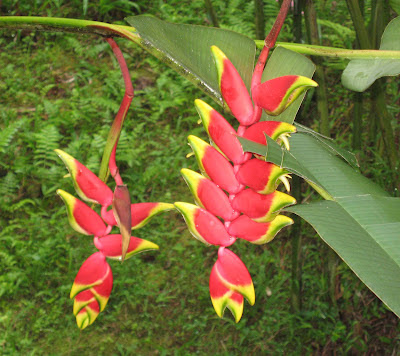 |
| Hawaii Tropical Botanical Garden, Hilo |
Last week, Art and I were on Hawaii’s Big Island. Most of the week was in Kona, where Art was attending a conference, but before it started we wanted to spend a day on the Hilo side of the island. The two sides of the Big Island, divided by mountains in the middle, are like Dr. Jekyll and Mr. Hyde, completely different in almost every way. The Kona side is dry, gently sloping, and vast volcanic flows cover the ground with chunks of black lava. Most of the large resorts are on the Kona side along the coast. The Hilo side is your mental image of Hawaii, lush, wet, green, with steep coastal cliffs indented by narrow gorges and spectacular waterfalls.
 |
| Waipio Valley, View from Overlook |
On our way to Hilo from the Kona airport we passed the turnoff to the
Waipio Valley and decided to make a slight detour. It was a sunny day, which meant that we would get a good view of the valley from the overlook. On a previous trip we had taken a hike to another supposed overlook but instead of a view of the 2000 foot drop to the valley floor, had seen nothing but clouds. This time, we were rewarded with a sweeping view of the valley with its patchwork of taro fields, the black sand beach, and the cliffs beyond. The road to the valley is so steep that only four wheel drive vehicles are allowed down. We did not have a 4WD car, so we contented ourselves with walking a short distance down and then huffing and puffing our way back to the top. On another trip in the future, we’d like to take a tour to the bottom. (You can arrange to go by car or by horseback.)
 |
| Hilo Bay, View from our Hotel Balcony |
We then drove from Waipio to Hilo. Hilo is built around a beautiful moon-shaped bay, famously susceptible to tsumanis. (All around the island you see signs posted directing you to tsunami evacuation routes.) After a powerful tsunami wiped out much of the bay front in 1946 and then again in 1960, it was decided to turn the low lying land around the bay into parks and hotels. We were assured that our hotel (the
Hilo Hawaiian Hotel), built at the edge of the water, was designed to withstand even a powerful tsunami surge, with an open lower structure that would allow water to flow right through. Our room, on the fifth floor, certainly had a spectacular view of the bay.
 |
| Bears' Coffee, Hilo |
Most of Hilo’s large hotels, including ours, are located on Banyan Drive, a loop road lined with huge banyan trees, each named after the famous person who planted it. Planted in the 1940's, the trees now tower over 100 feet high and their hanging roots are like small fortresses. That night we ate dinner at our favorite restaurant on the island, the
Hilo Bay Café. Located in a shopping mall, it doesn’t look fancy on the outside, but the food is fresh and creatively prepared.
[Update in 2015: The Hilo Bay Cafe has relocated to a building right on the water with a spectacular view over the bay. The food is still delicious!] In the morning, on the recommendation of our waitress at the Hilo Bay Cafe, we ate breakfast at Bear’s Coffee, a small café favored by locals where the food is fresh and inexpensive.
 |
| Hanging Lobster Claw, Hawaii Tropical Botanical Garden |
Our main goal for our day in Hilo was to revisit the amazing
Hawaii Tropical Botanical Garden, which we had first seen on a previous trip. The garden, nestled in a lush canyon just north of Hilo, features tropical plants from around the world, meticulously tended and clearly labeled. It is a photographer’s paradise. We worked our way down the steep path from the garden entrance past tumbling streams and waterfalls, brilliant colored plants with names like hanging lobster claw, beehive ginger and cannonball tree, to a koi pond, a cage of noisy macaws, and finally to a rocky beach at the bottom of the canyon. In an upcoming post, I will do a more detailed tour of the garden.
For a late lunch, we stopped a few miles up the road from the garden at What’s Shakin, where everything is made from locally grown produce. We bought sandwiches, a smoothie, a pineapple muffin, and a deliciously sweet papaya. We then headed for Kona, about a two and half hour drive to the other side of the island.
Note: Be sure you have a good
guidebook and
map for finding your way around the island. There are almost NO signs to attractions to help you know where to turn. Strict laws prohibit commercial signs except on your own property and then they can be no larger than 3 by 5 feet. Our favorite guidebook is
Hawaii, The Big Island Revealed by Andrew Doughty.
For my report on the
Kona side of Hawaii's Big Island go to my
May 13, 2013 post.
























